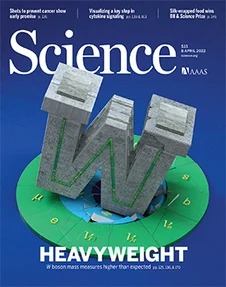Claudio Campagnari and Martijn Mulders in Science:
 Over the past 60 years, the standard model (SM) has established itself as the most successful theory of matter and fundamental interactions—to date. The 2012 discovery of the Higgs boson only added to the streak of triumphs for the theory (1, 2). However, the SM is known to be incomplete and has noticeable shortcomings, such as its inability to account for dark matter in the universe or to include gravity in a consistent fashion. Physicists have looked for phenomena that directly challenge the SM in the hope of finding hints on what a more complete theory may look like. Although no “new” particle has yet been found, a few fissures have recently been exposed in the SM by precise measurements that are at odds with the model’s predictions (3, 4). On page 170 of this issue, the Collider Detector at Fermilab (CDF) Collaboration (5) adds further intrigue with its measurement of the W boson mass.
Over the past 60 years, the standard model (SM) has established itself as the most successful theory of matter and fundamental interactions—to date. The 2012 discovery of the Higgs boson only added to the streak of triumphs for the theory (1, 2). However, the SM is known to be incomplete and has noticeable shortcomings, such as its inability to account for dark matter in the universe or to include gravity in a consistent fashion. Physicists have looked for phenomena that directly challenge the SM in the hope of finding hints on what a more complete theory may look like. Although no “new” particle has yet been found, a few fissures have recently been exposed in the SM by precise measurements that are at odds with the model’s predictions (3, 4). On page 170 of this issue, the Collider Detector at Fermilab (CDF) Collaboration (5) adds further intrigue with its measurement of the W boson mass.
The W boson, whose existence and detailed properties were first predicted in the 1960s and confirmed at CERN in 1983, is a key building block of the SM. It is a particle that is associated with the weak force, which is responsible for radioactive nuclear β decay, and that plays a similar role as that of the photon in the electromagnetic interaction.
More here.
